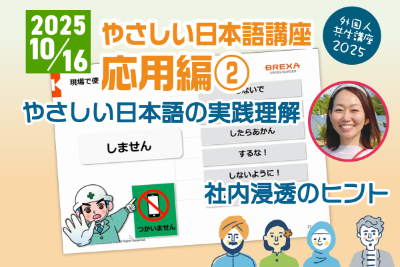- やさしい日本語
- ひらがなをつける
- Language
We provide multilingual content through machine translation. Translation accuracy is not 100%. About the multilingualization of the JAC website
- About JAC
- JAC Membership Information
- Specified Skilled Worker Acceptance
- Specified Skilled Worker Overview of the system
- 10 Mandatory Assistance for Foreigners
- Online individual consultation
- Seminar on Coexistence with Foreign Nationals
- Leading examples of host companies
- Case studies collection "Visionista"
- Foreigner's Voice
- Foreign Resident Acceptance Manual / Q&A
- Useful column "JAC Magazine"
- Acceptance support services
- Specified Skills Acceptance Support Service
- Health and Safety "Online Special Training"
- Safety and health “skills training”
- "Temporary Return Support" to ease the burden
- CCUS charge support
- Free Japanese language courses
- Education and Training Support
- Subsidy system for obtaining qualifications
- Support system for promoting the accumulation of employment history
- "Post-acceptance training" to deepen understanding of the system
- Compensation system for Specified Skilled Worker (i)
- freeJob matching
- The Specified Skills Evaluation Exam
- Home
- JAC Magazine
- JAC Initiatives and Activities Report
- Report on the "Plain Japanese Course Basics" for Japan employees
- Home
- JAC Magazine
- JAC Initiatives and Activities Report
- Report on the "Plain Japanese Course Basics" for Japan employees

Report on the "Plain Japanese Course Basics" for Japan employees
Since July 2024, JAC has been holding the "Plain Japanese Course" as a seminar for Japan employees.
Plain Japanese There are a total of 9 courses, 3 sessions of basic and applied (1) and 3 cools, and the second course started in October. Reflecting the voices of everyone who received it in the first cool, we increased the number of examples and held the 4th "Plain Japanese Course Basics".
Why do we need "Plain Japanese" now?
"Plain Japanese Course Basics" was held. This course was taught by Tomomi Kawamoto of ORJ Co., Ltd., and 189 people participated.
Since this is the basics, the course proceeded with the goal of understanding the "Plain Japanese" that is easy to convey to foreign workers.
In Part 1, we briefly explained the overview and examples of Plain Japanese.

Why do we need "Plain Japanese" now?
It has been found that "Plain Japanese" is a more effective means of communication than "English" for workers of various nationalities.
Using Plain Japanese provides the following benefits for businesses:
① Reduce misunderstandings about instructions and communication
- Creating a workplace that is easy for both Japanese and foreigners to work in
- Increased Productivity
② Nationality restrictions will be eliminated
- Ability to hire multinational talent
- It will be possible to find better talent, regardless of nationality
- Human resources can be developed equally regardless of nationality.
3) Improve your Japanese language skills
- Foreigners will be able to speak to each other in Japanese, improving their Japanese language skills.
- Activating communication and creating a brighter workplace
- Promoting communication with staff at work and preventing interpersonal problems
4. Improving productivity and preventing workplace accidents
- The range of work that can be taught will expand, skills and motivation will increase, and work efficiency and productivity can be expected to improve.
- This makes it easier to communicate safety instructions, helping to prevent accidents and injuries.
How to make Plain Japanese
And I learned about how to make "Plain Japanese".
" Plain Japanese" is based on the "law of scissors" that cuts (1) clearly (2) to the end (3) short.
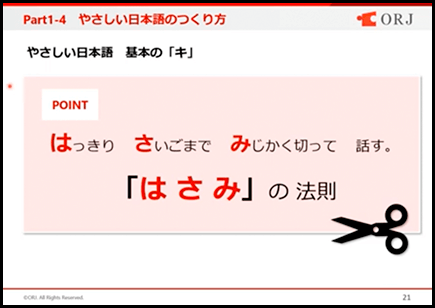
Let us state clearly, "until the end."
Next, I will introduce some common examples of not saying something "to the end" in Japanese.
Have you ever experienced a situation like this?
When Japanese people say "I'm busy," they can understand that "Oh, you still have other work to do today." However, foreign workers who are not familiar with Japanese only understand the word "busy."
Instead of just saying, "I'm busy today," be clear and communicate the message in full, saying, "I'd like you to work overtime. Please help me."
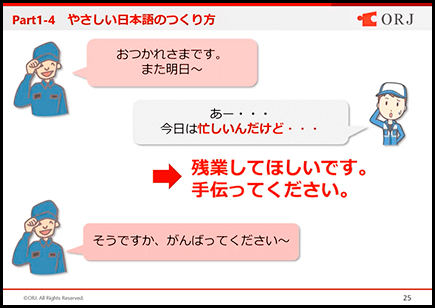
It may seem normal to Japanese people, but it confuses foreigners?!
In Part 2, we learned what the Japanese "N4" level is required for foreign workers and what a Plain Japanese is.
First, we practiced translating the information into Japanese that would be easy to understand.
Although it may seem like an easy word to Japanese people, I realized once again that I have no idea what "public transportation" is.
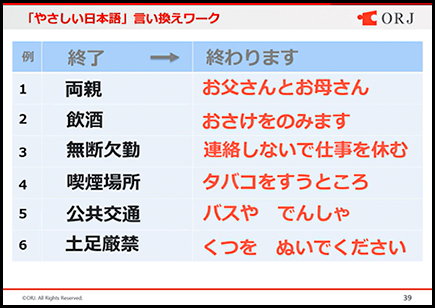
Then I learned the next most confusing Japanese word.
I think it is difficult for foreigners, just as I practiced counting things when I was little. Let's remember our old selves and tell them in Plain Japanese. "One day" is not only "tsuita" but also "ippi". It's already a mess. Dates and numbers are important messages, so changing them to a "gentle" way of saying them can prevent mistakes!
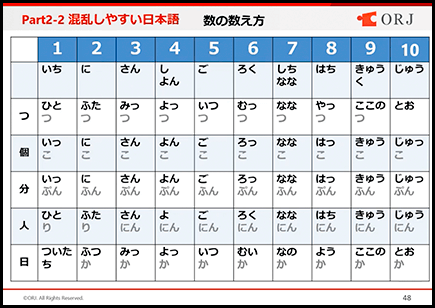
Finally, I learned Mehrabian's Law.
In communication, it seems that what we see and hear has more influence on people than words.
It is also a good idea to be conscious of communicating through facial expressions, tone of voice, and gestures.

Thank you very much for your comments and opinions.
At the end of the lecture there will be a question and answer session.
In addition to asking questions via chat, you can also raise your hand and ask the instructor a question verbally.
This time, the participants commented:
- There were easy-to-understand materials and exercises to do, so it was easy to follow.
- I found that words that we use casually every day are difficult for foreigners to understand.
- I learned how to communicate in a way that is easy to understand.
Such voices,
- Although I know that it is important to convey in Plain Japanese, there are times when I get frustrated when I don't understand the language in the field.
- I thought that by taking the lectures again, there would be a change in the way I treat foreign employees.
- I would like to spread what I learned today throughout the company.
I was happy that some of them led to the spread of "Plain Japanese".
We've read all of your survey responses! Thank you so much for all your opinions and feedback.
If you haven't participated yet, why don't you learn "Plain Japanese" once?
The "Plain Japanese Course" is a "Foreign Symbiosis Course" for Japan employees, and is developed as a practical course with cross-cultural understanding.
We look forward to your participation.
"Coexistence with Foreigners" Course for Japanese Employees
お問合せ:(株)ORJ 担当:三浦
e-mail:
Tel:
090-3150-0562
This article is a report on the "4th Plain Japanese Course Basics" held on Thursday, October 17, 2024.
Seminar Video
This video is from the "[1] Plain Japanese Course Basics for Japan Employees" held on January 16, 2025.
Seminar Materials
Plain Japanese Seminar materials for the basic course 241017.pdf
Report on the "Plain Japanese Lecture" for Japan Employees
I wrote the article!

Japan Association for Construction Human Resources Manager, Management Department (and Research Department)
Motoko Kano
Cano Motoko
Born in Aichi Prefecture.
He is in charge of public relations, research and investigation, and is the person behind social media.
We update our social media accounts daily with the desire to make people fall in love with Japan, to spread the appeal of construction from Japan to the world, and to ensure that Japan's construction industry continues to be the industry of choice around the world.
He is also engaged in research into the feasibility of implementing skills evaluation exam in Asian countries, and is conducting interviews with local organizations in each country.
Related articles
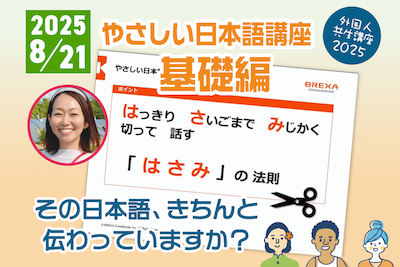
"Foreign Symbiosis Course 2025" for Japan Employees Plain Japanese Lecture (Basics) Report
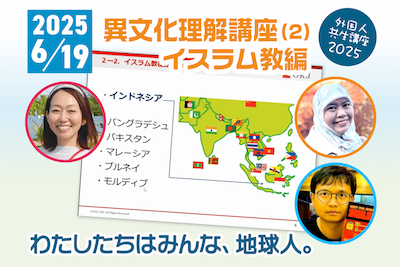
Report on the "Foreigner Coexistence Course 2025" for Japanese Employees: Intercultural Understanding Course (2) Islam
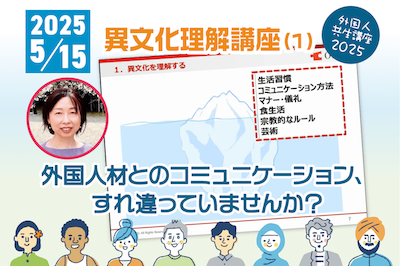
Report on the "Foreigner Coexistence Course 2025" Intercultural Understanding Course (1) for Japanese Employees
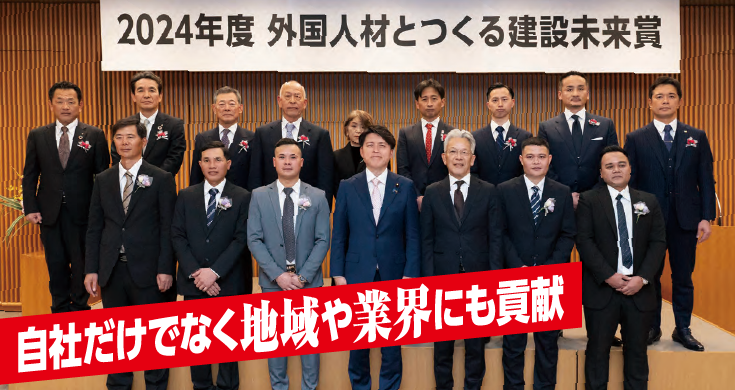
FY2024 "Construction Future Award with Foreign Talent" <Accepting Company/Organization Category> Award Ceremony Report












